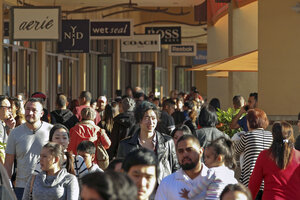Will US economic growth persuade the Fed to raise interest rates?
The US economy expanded 2.3 percent in the second quarter with the help of consumer spending. Although the Federal Reserve said it will keep interest rates near zero, the economic growth means a hike is still a possibility.

People shop during day after Christmas sales at Citadel Outlets in Los Angeles, California, in this file photo taken December 26, 2014. U.S. economic growth accelerated in the second quarter of 2015 as solid consumer spending offset the drag from weak business spending on equipment, suggesting a steady momentum that could bring the Federal Reserve closer to hiking interest rates this year.
Jonathan Alcorn/Reuters/File
The US economy gained momentum in the second quarter after a disappointing first quarter. Although the Federal Reserve said it is keeping interest rates at its near-zero levels, the growth in gross domestic product means the possibility is still on the table.
Gross domestic product grew 2.3 percent, thanks to an increase of exports and drop in imports, the Department of Commerce said Thursday. While economists predicted the economy expanding around 2.5 to 2.6 percent, the growth is refreshing news after the first quarter’s sluggish performance. Last quarter’s GDP, initially reported to dip 0.2 percent, was revised to show it growing at a 0.6 percent rate.
Part of the US economy’s growth spurt was fueled by consumers. In the second quarter, consumer spending rose 2.9 percent, compared to last quarter’s 1.8 percent increase. However, businesses did not echo consumers’ behavior: business investment declined, with equipment spending declining 4.1 percent.
The news also gives the Fed more to think about on whether or not it will raise interest rates. The central bank said on Wednesday after the central bank wrapped up its two-day policy meeting that it would still stick with its position of keeping interest rates between 0 and 0.25 percent. However, the Fed noted that economic activity had been growing moderately, thanks to household spending increasing and the housing market continuing to improve. In the meantime, people will have to wait and see for more indicators on a decision that affects nearly everyone in America.
Economists and analysts said the Fed’s upgraded outlook on the economy signals there could be an interest rate hike in September. While the Fed did not give a solid indication of a rate hike, the bank’s language was more positive about the economy than it was back in June, the Pittsburgh-based PNC Financial Services Group noted in a report released Wednesday.
“The previous statement did not make a reference to ‘continued’ improvement in the labor market, did not describe job gains as 'solid,’ and described the unemployment rate as 'steady' and not ‘declining,'" PNC economists wrote. That said, the timing of an increase depends on data over the next few months.
The economy’s moderate growth does not provide much ammunition for either side of the Fed’s rate-hike debate, wrote Joel L. Naroff, an economist at Naroff Economic Advisors. The revision to the first quarter helps, but is “nothing spectacular.” Vehicle spending, an improved housing market, and a narrowing trade deficit help boost the economy in the second quarter. Mr. Naroff expects that the US could see the economy growing 3 or more percent over the next quarter, though economists do not have any proof of it yet.
“For the Fed, the key numbers may be private domestic demand, which is growing solidly, and consumer inflation, which is slowly accelerating,” he wrote. “Everything considered, this report really doesn’t add much to the argument over whether the Fed should hike sooner or later. Data over the next two months retain their primary position in the decision process.”

